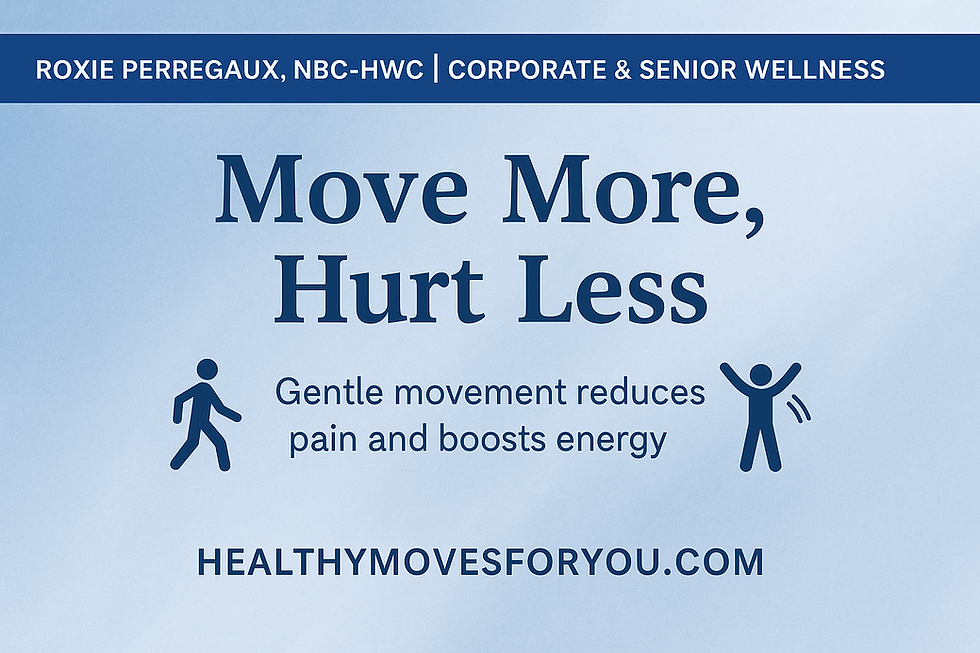The Importance of Balance for Seniors: How to Improve Stability and Prevent Falls
- Roxie Perregaux

- Jun 3
- 3 min read
As we age, maintaining balance becomes essential for overall health and well-being. Poor balance can lead to falls, which are a major cause of injury among seniors. However, balance can be improved with simple exercises, lifestyle changes, and awareness. In this post, I’ll share why balance is crucial for seniors and offer practical tips on how to improve it.
Why Balance is Important for Seniors
Maintaining good balance is vital for everyday activities, from walking and climbing stairs to simply standing up from a chair. As we age, the body’s ability to maintain stability naturally decreases, leading to a higher risk of falls. Falls can result in serious injuries, fractures, or even long-term disability, which is why preventing them is key to staying active and independent.
How Poor Balance Affects Seniors
Increased Fall Risk: Poor balance can make even simple movements risky, increasing the likelihood of falls and injuries.
Loss of Confidence: Seniors with poor balance may avoid physical activities out of fear of falling, leading to reduced mobility and a decline in overall health.
Decreased Independence: Without good balance, everyday tasks such as walking, dressing, or carrying groceries can become more difficult.
How to Improve Balance: Simple Tips and Exercises
Practice Balance ExercisesRegular balance exercises can help strengthen the muscles needed for stability and coordination. Here are a few exercises to try:
Standing on One Leg: Stand next to a chair or counter for support. Lift one leg off the ground and hold for 10-15 seconds, then switch legs. Gradually increase the duration as your balance improves.
Heel-to-Toe Walk: Walk in a straight line, placing one foot directly in front of the other as if walking on a tightrope. This exercise improves coordination and balance.
Strengthen Your CoreA strong core is essential for maintaining stability and preventing falls. Some simple core-strengthening exercises include:
Seated Leg Lifts: Sit in a chair with your back straight and legs bent. Slowly lift one leg off the ground, hold it for a few seconds, and then lower it back down. Repeat with the other leg.
Bridges: Lie on your back with your knees bent and feet flat on the floor. Lift your hips off the floor, engaging your core and glutes, and hold for a few seconds before lowering.
Stay ActiveRegular physical activity is key to maintaining overall balance. Activities like walking, swimming, or tai chi improve coordination, flexibility, and strength, all of which contribute to better balance. Aim for at least 30 minutes of moderate exercise most days of the week.
Be Mindful of Your EnvironmentMake sure your home is safe and free of obstacles that could cause you to trip or lose your balance. Remove rugs, keep walkways clear, and install grab bars in the bathroom or other places where you may need extra support.
Use Assistive Devices if NeededIf you find it difficult to maintain your balance, consider using assistive devices such as a cane or walker to provide extra stability when walking. Talk to your healthcare provider about whether these devices might be helpful for you.
Conclusion: Balance = Confidence and Independence
Improving balance is one of the most important things seniors can do to maintain their independence and reduce the risk of falls. By practicing balance exercises, strengthening your core, staying active, and making your environment safer, you can improve your stability and feel more confident in your daily life.
Remember, even small improvements in balance can make a big difference in your overall quality of life. Start slow, stay consistent, and enjoy the benefits of better balance!




Comments